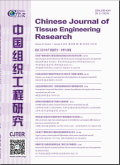- 钛学术文献服务平台 \
- 学术期刊 \
- 医药卫生期刊 \
- 基础医学期刊 \
- 中国组织工程研究期刊 \
Superparamagnetic iron oxide nanoparticles label human bone marrow and umbilical cord mesenchymal stem cells
Superparamagnetic iron oxide nanoparticles label human bone marrow and umbilical cord mesenchymal stem cells
基本信息来源于合作网站,原文需代理用户跳转至来源网站获取
摘要:
BACKGROUND: Nowadays, it is becoming more and more important to optimize safety of human derived cel s, label cel s efficiently and track cel s after cel s transplantation both in basic research and clinic application.
OBJECTIVE: To compare the cel viability, labeling efficiency and imaging effect of the T2* weight image (WI) magnetic resonance (MR) between the human bone marrow and umbilical cord derived mesenchymal stem cel s labeled with the superparamaganetic iron oxide nanoparticles, as wel as to optimize their treatment efficiency.
METHODS: The third generation of human bone marrow and umbilical cord derived mesenchymal stem cel s were cultured, and labeled with 5-30 mg/L Feridex Ⅳ and protamine sulfate.
RESULTS AND CONCLUSION: The viability of human bone marrow mesenchymal stromal cel s was similar with human umbilical cord derived mesenchymal stem cel s (P >0.05). There was no significant difference of labeling rate between the bone marrow msenchymal stem cel s labeled with 5-30 mg/L Feridex Ⅳ(P >0.05); while there was significant difference of labeling rate between the umbilical cord derived mesenchymal stem cel s labeled with 5 mg/L Feridex Ⅳ and 20 and 30 mg/L Feridex Ⅳ(P <0.05); the positive labeling rate of umbilical cord derived mesenchymal stem cel s was lower than that of bone marrow msenchymal stem cel s after labeled with 10 mg/L FeridexⅣ(P <0.05). When two sources of cel s were labeled with Feridex Ⅳ more than 2 mg/L, the iron oxide particles were found in the cel suspension and could not be removed by elution and filtration. The signal intensity from 3.0T MR GRE T2*WI scan was decreased with the increasing of Feridex Ⅳ concentration in both cel types. It is safe and effective to label the two tissue-derived mesenchymal stem cel s with 10 mg/L Feridex Ⅳ-protamine sulfate complex, and can be observed with T2*WI MR.

推荐文章
内容分析
关键词云
关键词热度
相关文献总数
(/次)
(/年)
引文网络
引文网络
二级参考文献 (28)
共引文献 (13)
参考文献 (19)
节点文献
引证文献 (2)
同被引文献 (5)
二级引证文献 (0)
1958(1)
- 参考文献(1)
- 二级参考文献(0)
1989(1)
- 参考文献(0)
- 二级参考文献(1)
1992(1)
- 参考文献(1)
- 二级参考文献(0)
1999(5)
- 参考文献(0)
- 二级参考文献(5)
2000(1)
- 参考文献(0)
- 二级参考文献(1)
2002(1)
- 参考文献(0)
- 二级参考文献(1)
2003(5)
- 参考文献(0)
- 二级参考文献(5)
2004(3)
- 参考文献(0)
- 二级参考文献(3)
2005(2)
- 参考文献(0)
- 二级参考文献(2)
2006(4)
- 参考文献(1)
- 二级参考文献(3)
2007(3)
- 参考文献(2)
- 二级参考文献(1)
2008(4)
- 参考文献(2)
- 二级参考文献(2)
2009(5)
- 参考文献(2)
- 二级参考文献(3)
2010(6)
- 参考文献(5)
- 二级参考文献(1)
2011(4)
- 参考文献(4)
- 二级参考文献(0)
2012(1)
- 参考文献(1)
- 二级参考文献(0)
2012(1)
- 参考文献(1)
- 二级参考文献(0)
- 引证文献(0)
- 二级引证文献(0)
2013(1)
- 引证文献(1)
- 二级引证文献(0)
2015(1)
- 引证文献(1)
- 二级引证文献(0)
引文网络交叉学科
相关学者/机构
期刊影响力
中国组织工程研究
主办单位:
中国康复医学会
《中国组织工程研究与临床康复》杂志社
出版周期:
旬刊
ISSN:
2095-4344
CN:
21-1581/R
开本:
大16开
出版地:
沈阳浑南新区10002信箱
邮发代号:
8-584
创刊时间:
1997
语种:
chi
出版文献量(篇)
55677
总下载数(次)
80
期刊文献
相关文献
推荐文献
- 期刊分类
- 期刊(年)
- 期刊(期)
- 期刊推荐
中国组织工程研究2022
中国组织工程研究2021
中国组织工程研究2020
中国组织工程研究2019
中国组织工程研究2018
中国组织工程研究2017
中国组织工程研究2016
中国组织工程研究2015
中国组织工程研究2014
中国组织工程研究2013
中国组织工程研究2012
中国组织工程研究2011
中国组织工程研究2010
中国组织工程研究2009
中国组织工程研究2008
中国组织工程研究2007
中国组织工程研究2006
中国组织工程研究2005
中国组织工程研究2004
中国组织工程研究2003
中国组织工程研究2002
中国组织工程研究2001
中国组织工程研究2000
中国组织工程研究1999
中国组织工程研究1998
中国组织工程研究2012年第9期
中国组织工程研究2012年第8期
中国组织工程研究2012年第7期
中国组织工程研究2012年第6期
中国组织工程研究2012年第53期
中国组织工程研究2012年第52期
中国组织工程研究2012年第51期
中国组织工程研究2012年第50期
中国组织工程研究2012年第5期
中国组织工程研究2012年第49期
中国组织工程研究2012年第48期
中国组织工程研究2012年第47期
中国组织工程研究2012年第46期
中国组织工程研究2012年第45期
中国组织工程研究2012年第44期
中国组织工程研究2012年第43期
中国组织工程研究2012年第42期
中国组织工程研究2012年第41期
中国组织工程研究2012年第40期
中国组织工程研究2012年第4期
中国组织工程研究2012年第39期
中国组织工程研究2012年第38期
中国组织工程研究2012年第37期
中国组织工程研究2012年第36期
中国组织工程研究2012年第35期
中国组织工程研究2012年第34期
中国组织工程研究2012年第33期
中国组织工程研究2012年第32期
中国组织工程研究2012年第31期
中国组织工程研究2012年第30期
中国组织工程研究2012年第3期
中国组织工程研究2012年第29期
中国组织工程研究2012年第28期
中国组织工程研究2012年第27期
中国组织工程研究2012年第26期
中国组织工程研究2012年第25期
中国组织工程研究2012年第24期
中国组织工程研究2012年第23期
中国组织工程研究2012年第22期
中国组织工程研究2012年第21期
中国组织工程研究2012年第20期
中国组织工程研究2012年第2期
中国组织工程研究2012年第19期
中国组织工程研究2012年第18期
中国组织工程研究2012年第17期
中国组织工程研究2012年第16期
中国组织工程研究2012年第15期
中国组织工程研究2012年第14期
中国组织工程研究2012年第13期
中国组织工程研究2012年第12期
中国组织工程研究2012年第11期
中国组织工程研究2012年第10期
中国组织工程研究2012年第1期

 免费查重
免费查重










